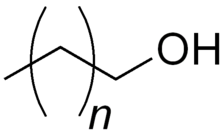Policosanol: Difference between revisions
No edit summary |
No edit summary |
||
| Line 41: | Line 41: | ||
Policosanol was originally derived from [[sugar cane]] but the chemicals can also be isolated from beeswax, cereal grains, grasses, leaves, fruits, nuts, and seeds of many foods.<ref name=2010Rev/> Plant waxes consist of very long chain [[fatty acids]] that have been [[esterification|esterified]] to very long chain alcohols. Policosanols are very long chain alcohols with carbon backbones ranging from 24 to 34 carbons.<ref name=2010Rev/> |
Policosanol was originally derived from [[sugar cane]] but the chemicals can also be isolated from beeswax, cereal grains, grasses, leaves, fruits, nuts, and seeds of many foods.<ref name=2010Rev/> Plant waxes consist of very long chain [[fatty acids]] that have been [[esterification|esterified]] to very long chain alcohols. Policosanols are very long chain alcohols with carbon backbones ranging from 24 to 34 carbons.<ref name=2010Rev/> |
||
The first policosanol supplements were produced by Dalmer Laboratories in Cuba; studies conducted and published by that group have found that policosanol is safe and effective as a [[lipid-lowering agent]]. However these studies were small, and efforts by groups outside of Cuba have failed to replicate these results.<ref name=2010Rev>{{cite journal | |
The first policosanol supplements were produced by Dalmer Laboratories in Cuba; studies conducted and published by that group have found that policosanol is safe and effective as a [[lipid-lowering agent]]. However these studies were small, and efforts by groups outside of Cuba have failed to replicate these results.<ref name=2010Rev>{{cite journal |doi=10.1080/10408391003626249 }}</ref> |
||
| ⚫ | Meta-analysis in 2005 found that human policosanol consumption is safe and well tolerated and is effective at lowering the blood cholesterol.<ref name=MetaAnalysis>{{cite journal | |
||
| ⚫ | Meta-analysis in 2005 found that human policosanol consumption is safe and well tolerated and is effective at lowering the blood cholesterol.<ref name=MetaAnalysis>{{cite journal |doi=10.1592/phco.25.2.171.56942 }}</ref> As of 2010, they were marketed as lipid-lowering agents in the Caribbean, Central and South America, and Canada.<ref name=2010Rev/> Recently, blood pressure lowering effect of cuban policosanol has been proved in animal model using spontaneously hypertensive rats (SHR)<ref>{{cite journal |doi=10.3390/molecules23051080 }}</ref> and human trial.<ref>{{cite journal |doi=10.1155/2018/4809525 }}</ref><ref>{{cite journal |doi=10.3389/fphys.2018.00412 }}</ref> |
||
== References == |
== References == |
||
Revision as of 12:52, 8 September 2018
 | |
| Clinical data | |
|---|---|
| AHFS/Drugs.com | International Drug Names |
| ATC code | |
| Identifiers | |
| |
| CAS Number | |
| ChemSpider |
|
| CompTox Dashboard (EPA) | |
| Chemical and physical data | |
| Formula | CH3-(CH2)n-CH2OH n=24-34 |
| Molar mass | (variable) |
| | |
Policosanol is the generic term for a mixture of long chain alcohols extracted from plant waxes. It is used as a dietary supplement.
Policosanol was originally derived from sugar cane but the chemicals can also be isolated from beeswax, cereal grains, grasses, leaves, fruits, nuts, and seeds of many foods.[1] Plant waxes consist of very long chain fatty acids that have been esterified to very long chain alcohols. Policosanols are very long chain alcohols with carbon backbones ranging from 24 to 34 carbons.[1]
The first policosanol supplements were produced by Dalmer Laboratories in Cuba; studies conducted and published by that group have found that policosanol is safe and effective as a lipid-lowering agent. However these studies were small, and efforts by groups outside of Cuba have failed to replicate these results.[1]
Meta-analysis in 2005 found that human policosanol consumption is safe and well tolerated and is effective at lowering the blood cholesterol.[2] As of 2010, they were marketed as lipid-lowering agents in the Caribbean, Central and South America, and Canada.[1] Recently, blood pressure lowering effect of cuban policosanol has been proved in animal model using spontaneously hypertensive rats (SHR)[3] and human trial.[4][5]
References
- ^ a b c d . doi:10.1080/10408391003626249.
{{cite journal}}: Cite journal requires|journal=(help); Missing or empty|title=(help) - ^ . doi:10.1592/phco.25.2.171.56942.
{{cite journal}}: Cite journal requires|journal=(help); Missing or empty|title=(help) - ^ . doi:10.3390/molecules23051080.
{{cite journal}}: Cite journal requires|journal=(help); Missing or empty|title=(help)CS1 maint: unflagged free DOI (link) - ^ . doi:10.1155/2018/4809525.
{{cite journal}}: Cite journal requires|journal=(help); Missing or empty|title=(help)CS1 maint: unflagged free DOI (link) - ^ . doi:10.3389/fphys.2018.00412.
{{cite journal}}: Cite journal requires|journal=(help); Missing or empty|title=(help)CS1 maint: unflagged free DOI (link)
External links
- Policosanol at Drugs.com
